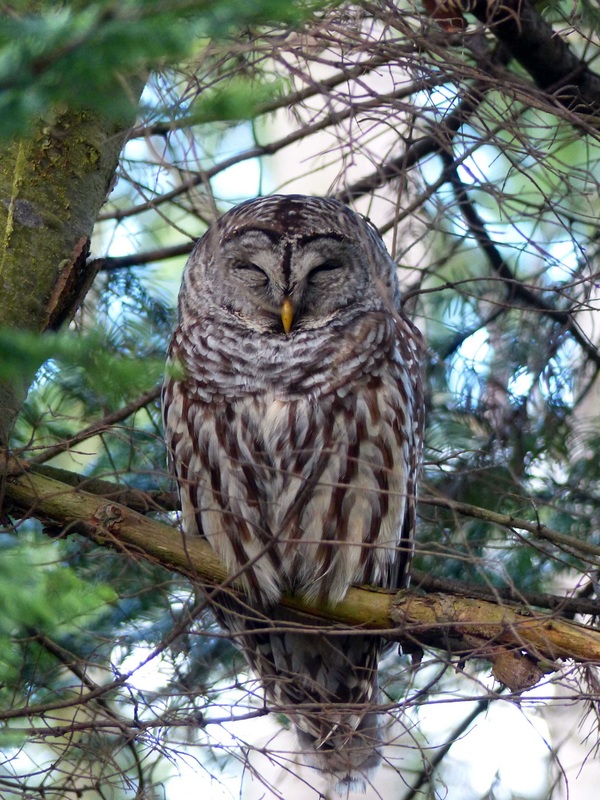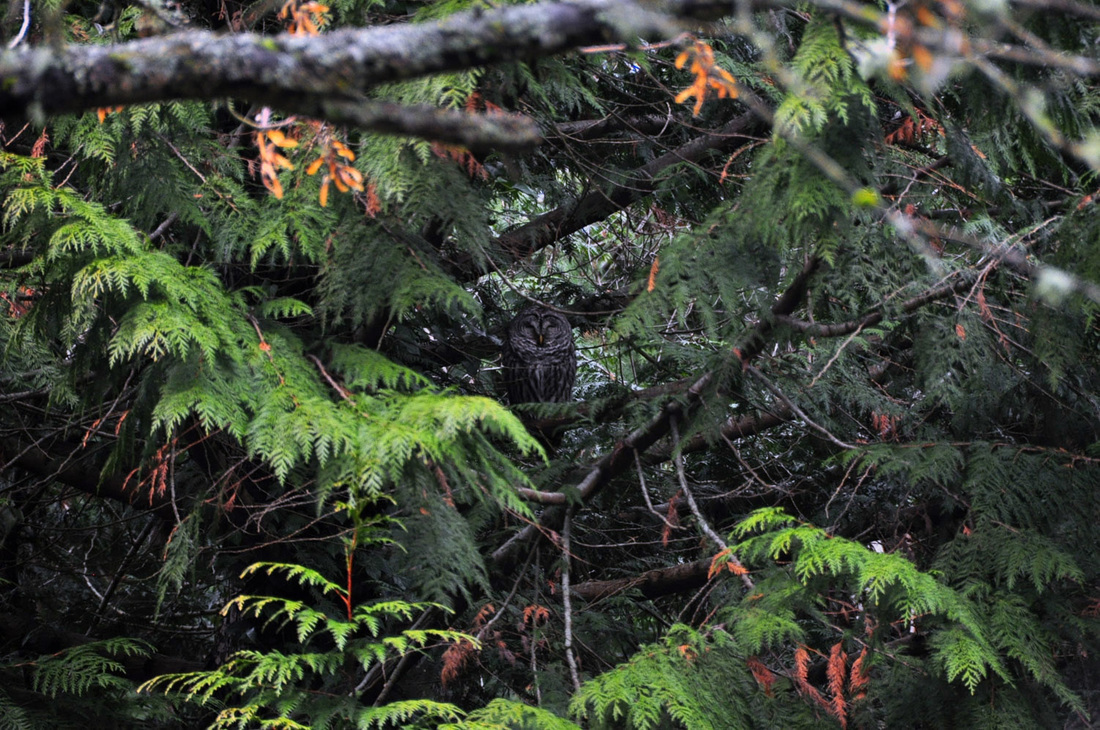Barred owl • Strix varia
Identification
The barred owl (not to be misheard and mistaken for the barn owl) is named for the brown barring on its upper breast, and the light barring on its brown tail. Other identifying features are the dark vertical stripes that streak its undersides below the barred breast, its dark eyes, and its yellow bill. It also has a distinctive call ("who-cooks-for-you, who-cooks-for-you-all") and various other barks and screams. This large owl can be up to half a metre in length.
Visit the BC Breeding Bird Atlas species page for more information.
Habitat & Range
This owl is found in coniferous and mixed coniferous-deciduous forests, including low-lying and swampy areas. Its range covers much of eastern North America, and it expanded westward rapidly during the twentieth century to include much of British Columbia and the Pacific Northwest. Click here for a range map.
Similar Species
The similar northern spotted owl (Strix occidentalis ssp. caurina) is found in part of the Pacific Northwest, and overlaps in range with the barred owl along the coast of southern BC, northern Washington, Oregon, and northern California. Its undersides are brown with white spotting instead of the barred owl's light with brown streaks and bars.
Intriguing Info
The expansion of the barred owl to the west coast of North America has had a negative impact on both the northern spotted owl and the western screech owl (Megascops kennicottii), both of which are also threatened by habitat loss. The barred owl competes and hybridizes with the spotted owl, and it preys upon the screech owl. See the BC Breeding Bird Atlas species page for possible causes of this expansion.
iNaturalist
https://www.inaturalist.org/taxa/19893-Strix-varia
The barred owl (not to be misheard and mistaken for the barn owl) is named for the brown barring on its upper breast, and the light barring on its brown tail. Other identifying features are the dark vertical stripes that streak its undersides below the barred breast, its dark eyes, and its yellow bill. It also has a distinctive call ("who-cooks-for-you, who-cooks-for-you-all") and various other barks and screams. This large owl can be up to half a metre in length.
Visit the BC Breeding Bird Atlas species page for more information.
Habitat & Range
This owl is found in coniferous and mixed coniferous-deciduous forests, including low-lying and swampy areas. Its range covers much of eastern North America, and it expanded westward rapidly during the twentieth century to include much of British Columbia and the Pacific Northwest. Click here for a range map.
Similar Species
The similar northern spotted owl (Strix occidentalis ssp. caurina) is found in part of the Pacific Northwest, and overlaps in range with the barred owl along the coast of southern BC, northern Washington, Oregon, and northern California. Its undersides are brown with white spotting instead of the barred owl's light with brown streaks and bars.
Intriguing Info
The expansion of the barred owl to the west coast of North America has had a negative impact on both the northern spotted owl and the western screech owl (Megascops kennicottii), both of which are also threatened by habitat loss. The barred owl competes and hybridizes with the spotted owl, and it preys upon the screech owl. See the BC Breeding Bird Atlas species page for possible causes of this expansion.
iNaturalist
https://www.inaturalist.org/taxa/19893-Strix-varia
References
Cannings, R.J. (2015). Barred Owl in Davidson, P.J.A., R.J. Cannings, A.R. Couturier, D. Lepage, and C.M. Di Corrado (eds.). The Atlas of the Breeding Birds of British Columbia, 2008-2012. Bird Studies Canada. Delta, B.C.
Dunn, J. L. and Alderfer, J. (Eds.). (2011). National Geographic Field Guide to the Birds of North America. (6th Ed.). Washington, D.C.: National Geographic Society. Pp. 284-285.
Barred Owl Strix varia. The Birds of North America Online (A. Poole, Ed.). Ithaca: Cornell Lab of Ornithology. Retrieved from the Birds of North America Online. Accessed 04/04/2018.
Authors and editors of page
Kelly Fretwell (2018)
Cannings, R.J. (2015). Barred Owl in Davidson, P.J.A., R.J. Cannings, A.R. Couturier, D. Lepage, and C.M. Di Corrado (eds.). The Atlas of the Breeding Birds of British Columbia, 2008-2012. Bird Studies Canada. Delta, B.C.
Dunn, J. L. and Alderfer, J. (Eds.). (2011). National Geographic Field Guide to the Birds of North America. (6th Ed.). Washington, D.C.: National Geographic Society. Pp. 284-285.
Barred Owl Strix varia. The Birds of North America Online (A. Poole, Ed.). Ithaca: Cornell Lab of Ornithology. Retrieved from the Birds of North America Online. Accessed 04/04/2018.
Authors and editors of page
Kelly Fretwell (2018)






